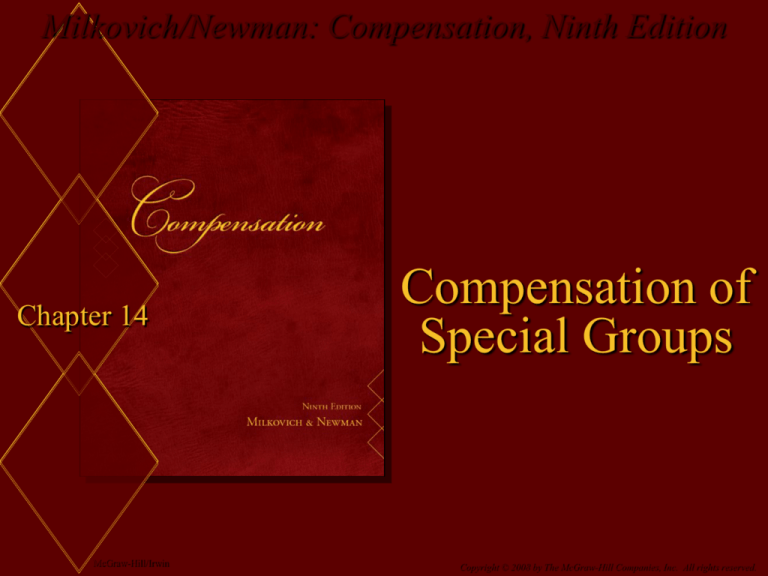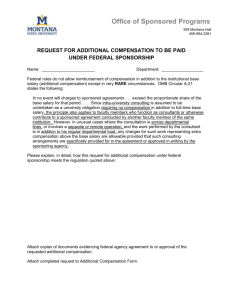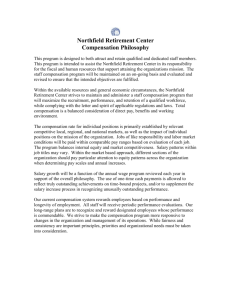
Milkovich/Newman: Compensation, Ninth Edition
Chapter 14
McGraw-Hill/Irwin
Compensation of
Special Groups
Copyright © 2008 by The McGraw-Hill Companies, Inc. All rights reserved.
Report: Workers Want Vastly Different
Rewards
More than half of those surveyed agree that quality of Co’s recognition efforts
affects how they perform their job, w/ only 10% completely satisfied w/ their Co’s
rewards program
–
70% receive verbal praise, but only 49% want it
–
40% who want written praise receive it
–
30% who want to be singled out thru special event are recognized that way
–
29% who want cash bonus as recognition for their work receive it
–
27% who want incentives such as award merchandise, gift cards, or trips receive them
–
27% who want award such as trophy or plaque receive it
“This study shows Ees are motivated in vastly different ways and Cos still have a
long way to go to ensure their Ees feel valued”
–
64% said their Co should offer greater choice of workplace rewards when it comes to
recognizing efforts
14-2
Report: Workers Want Vastly Different
Rewards
Reducing Ee turnover and becoming an Er of choice are two of most
pressing concerns Cos have today
Compared to Ees unsatisfied w/ their Ee recognition program, Ees who are
completely satisfied with it are:
– 11x as likely to be satisfied w/ job
– 7x as likely to spend careers w/ Co
– 7x as likely to recommend their org to others
– 6x as likely to invest $ in their Co if they could
– 5x as likely to feel highly valued at work
One way to add freshness and enthusiasm is by forming advisory panel of
people from different job levels and parts of Co
Source: HRNews Online, 2/8/06
14-3
Issues: Supervisory Pay
Major challenge in paying supervisors
– Equity
Provide incentives to entice nonexempt employees
to accept challenges of being a supervisor
14-4
Strategies: Supervisory Pay
Pay strategies
– Key base salaries of supervisors to an amount
exceeding highest paid employee
– Pay supervisors for scheduled overtime
Trend in supervisory compensation
– Increased use of variable pay
More than half of all companies have a variable pay
component for supervisors
14-5
Explanations for CEO Compensation
Social comparisons
– Executive salaries bear a consistent relative
relationship to pay of lower-level employees
Economic approach
– Value of CEO should correspond to some measure
of organizational success
Agency theory
– Incorporates political motivations
– CEO compensation should be designed to ensure
executives focus on best interests of firm and
stockholders
14-6
Components of an Executive
Compensation Package
Base salary
Short-term (annual) incentives or bonuses
Long-term incentives and capital appreciation
plans
Executive benefits
Perquisites
14-7
Exhibit 14.4: Breakdown of Executive
Compensation Components
14-8
Executive Compensation
Two factors contributed to pay scales that now
have CEOs earning more than 300x pay of
average American worker
– Advent of giant stock option grants, form of
compensation made more attractive by 1993 change
to tax law that maintained corporate tax deductions
for executive pay over $1m if pay was tied to
performance
– Widespread practice of linking pay to levels at
companies of similar size
Has effect to raise average that everyone will use as
baseline
Source: New York Times, 4/5/09
14-9
14-10
Executive Compensation (Wall Street
Journal study)
Median total compensation, 2009, $6.95m, down 0.9%
from 2008 (includes salary, bonuses, value of restricted
stock at time of grant, gains from options exercises, other
long-term incentives)
– Had declined 3.4% from 2007 to 2008
– Long-term incentive awards declined 4.6% to median $5m
– Median salaries and bonuses up 3.2%, to $2.64m
Companies run by best-paid CEOs generally deliver betterthan-average shareholder returns
– But not uniformly true
Source: Wall Street Journal, 4/1/10, based on analysis of 200 major U.S.
corporations by Hay Group
14-11
Competitive Benchmarking
Most companies historically have benchmarked executive
compensation
– Practice tends to inflate compensation
If all orgs seek to pay median or above, median will inevitably rise
(see Business Week Commentary, “The Artificial Sweetener in CEO
Pay” on website)
– Practice tends to disregard relationship between pay and company
performance
– Some movement to tie pay to performance of peer group
Source: Wall Street Journal, 4/12/04
In 1960, CEOs earned average of 2x as much as president of U.S.;
today, 30x
Source: Wall Street Journal, 7/19/05, 1/21/06
14-13
International Comparisons
Median salary plus cash bonus for U.S. CEOs in office at least one year was $2.3m
in 2004, according to analysis by Boardex of London
–
U.K.: $1.2m
–
France: $857k
–
Sweden: $386k
Pay gap between U.S. and Asian CEOs even larger, according to analysis by
Mercer
–
Japan: $318k
–
Hong Kong: $302k
–
Singapore: $263k
–
India: $88k
Source: Wall Street Journal, 7/19/05
Average CEO’s salary in U.S. is 475x average ee’s salary, cf. 11x in Japan, 15x in
France, 20x in Canada, 22x in U.K.
Source: Wall Street Journal, 1/21/06
14-14
Putting a Ceiling on Pay
Growing number of shareholder activists pushing Cos to establish
maximum ratios between what their executives earn and what their
average- or lowest-paid workers earn
Average CEO in U.S. earned 282x salary of average worker in 2002, cf.
42x in 1982
– Whole Foods Market (leading organic food retailer) limits any executive’s pay
to no more than 14x pay of average worker (current cap is $409k)
– Ben & Jerry’s had capped pay at 7x pay of lowest worker, but dropped policy
in 1994
– Herman Miller had capped pay at 20x, but dropped policy in 1996
Critics argue that such practices that exclude stock options are of little
value
Source: Wall Street Journal, 4/12/04
14-15
Exhibit 14.7: Description of Long-Term
Incentives for Executives
Incentive stock options
Non-qualified stock options
Phantom stock plans
Stock appreciation rights
Restricted stock plans
Performance share/unit plans
14-16
Long-Term Incentives
Stock option: right granted an executive to purchase stock at a fixed
price over a fixed period of time
– Incentive stock options (no taxes at grant or exercise for Ee, no
deduction as expense for Co)
– Nonqualified options (do not have restrictions such as minimum
holding time or price requirements; taxed as ordinary income at
exercise [on difference between exercise price and fair market value
at time of exercise], Co may deduct)
14-17
Long-Term Incentives
Stock purchase plans: allow a short time to exercise
purchase rights at a set price
Restricted stock: the outright grant of stock to an
executive at no or very low cost but subject to
restrictions
– Phantom stock (“units” granted that can be cashed in)
– Performance-accelerated restricted stock (shares earned earlier
if performance targets met)
14-18
Long-Term Incentives
Performance-based goal attainment plans: provide the executive a
number of units or shares of stock if predetermined long-term goals
are met within a specified time period
– Formula value grants (value based on formula)
– Formula value appreciation grants (value based on appreciation of
unit over period)
– Full-value grants (full value, not appreciation)
– Dividend units grants (dividend entitlement)
14-19
Exhibit 14.8: Popular Perks
Offered to Executives
Physical exam
Company car
Financial counseling
Company plane
Income tax preparation
First-class air travel
Country club membership
Luncheon club
membership
Estate planning
Personal liability insurance
Spouse travel
Chauffeur service
Reserved parking
Executive dining room
Home security system
Car phone
Financial seminars
Loans at low or no interest
Legal counseling
14-20
Perks on the Decline?
18% of top officers received company car in 2002, down from
56% in 1998
8% received country club membership, down from 54% in 1998
3% received health club membership, down from 23% in 1998
2% received sports/theater tickets, down from 46% in 1998
Source: Wall Street Journal, 4/14/03
But, 52% of companies covered cost of personal air travel by
their CEOs in 2008, w/ median value of $115k
– Another controversial benefit: tax ‘gross-ups’ on perks (which cover taxes
owed by execs for Er-provided perks and other benefits), provided by
38% of companies, w/ median value of $16.4k
Source: Wall Street Journal, 4/3/09
41 of the 200 companies in the 2009 pay survey have eliminated
at least one perk, compared w/ 27 in 2008
– Biggest target: ‘gross-ups’ (29 companies nixed at least one such
payment)
Source: Wall Street Journal, 4/1/10
14-21
Reward Components: Professional Employees
Dual-career
ladders
Performance-based incentives
– Profit sharing
– Stock ownership
Bonuses
– Completion of projects on or before deadlines
– Patents
– Publications
– Elections to professional societies
– Attainment of professional licenses
Perks
based on unique needs of professional
employees
14-22
Exhibit 14.9: IBM Dual Ladders
14-23
Exhibit 14.10: Maturity Curve: Years Since Last Degree
Relative to Salary
14-24
Exhibit 14.11: Sales Compensation
Components
14-25
Key Factors: Designing a Sales
Compensation Plan
Nature of people who enter sales profession
Organizational strategy
Market maturity
Competitor practices
Economic environment
Product sold
14-26
Sales Compensation Packages
Guaranteed base salary
Guaranteed base salary + commission
Guaranteed base salary + bonus
Guaranteed base salary + commission + bonus
Commission only
14-27
Key Issues in Contingent Workforce
Compensation
Identify
ways to deal with equity issues
– View workers as pool of
candidates for more
permanent hiring status
– Champion idea of
boundary less careers
14-28






